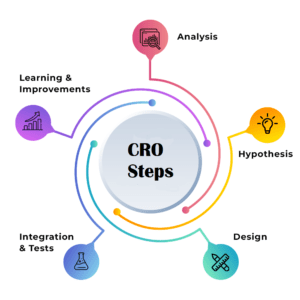What is conversion Rate Optimization?
Conversion rate optimization (CRO) is a process used to improve the performance of a digital asset by increasing the percentage of visitors taking action, for example, making a purchase or filling out a form. The goal of CRO is to turn more website visitors into customers by identifying and addressing the obstacles that prevent them from converting. CRO is a data-driven approach, utilizing techniques such as A/B testing, user research, and analytics to understand user behavior and identify areas for improvement.
The CRO process typically begins with setting clear conversion goals and identifying the key performance indicators (KPIs) used to measure success. The website is then analyzed to identify areas of friction, such as long load times, confusing navigation, or a lack of trust signals. The next step is to develop and test hypotheses for improvement, for example, redesigning the website’s call-to-action button or simplifying the checkout process.
A/B testing is a useful tool in CRO to compare different versions of a website or landing page to determine which elements are most effective in encouraging visitors to convert. The heat maps and user research can also be used to understand how users interact with the website and identify areas of confusion or frustration.
Once improvements are made, the website is monitored to ensure that the changes positively impact conversion rates. It is also important to continue testing and optimizing over time, as user behavior and website best practices constantly evolve.
Benefits of conversion rate optimization
Conversion rate optimization (CRO) offers many benefits for businesses looking to improve their website or landing page performance. Some of the key benefits include:
- Increased revenue: By converting more website visitors into customers, CRO can help increase website revenue and drive more sales.
- Improved ROI: CRO allows businesses to get more value from their existing website traffic without investing in additional marketing efforts to drive more traffic.
- Better customer experience: By identifying and addressing obstacles that prevent visitors from converting, CRO can help improve a website’s overall user experience and make it more user-friendly.
- Increased lead generation: CRO can help businesses generate more leads by making it easier for visitors to fill out forms and submit contact information.
- Greater customer insights: By analyzing user behavior and testing different website elements, CRO can help businesses gain a better understanding of customers and needs.
- Better decision-making: Businesses can make more informed decisions about their website and marketing strategy using data and testing results from CRO.
- Competitive edge: By optimizing their website and improving conversion rates, businesses can gain an advantage over competitors and stand out in a crowded online marketplace.
Drawbacks of not implementing CRO.
Not using the conversion rate optimization (CRO) process can result in several challenges for organizations looking to improve the performance of their website or landing page. Some of these challenges include:
- Low conversion rates: Without CRO, organizations may not be able to convert website visitors into customers, resulting in low conversion rates and missed revenue opportunities.
- Poor user experience: Organizations must understand and address the obstacles that prevent visitors from converting to provide a better user experience, resulting in high bounce rates and low customer satisfaction.
- Inefficient use of resources: Without CRO, organizations may invest in marketing efforts to drive more traffic to their website without fully utilizing the potential of the existing traffic.
- Limited customer insights: Organizations must understand and analyze user behavior to comprehensively understand their customers and needs, making it easier to develop effective marketing strategies.
- Difficulty in decision-making: Organizations may need more data and testing results from CROs to make informed decisions about their website and marketing strategy.
- Lack of competitive edge: Organizations must optimize their website and improve conversion rates to ensure they stand out in a crowded online marketplace.
- Missed revenue opportunities: Without CRO, organizations may miss out on the opportunity to increase revenue and drive more sales, which could lead to a decrease in overall profitability.
- Difficulty in allocating budget: Organizations must understand the effectiveness of their website and marketing efforts through CRO to allocate budget to where it’s most needed.
- Difficulty in identifying areas for improvement: Without CRO, organizations may not be able to identify specific areas of their website that need improvement and thus may be able to make targeted changes to improve conversion rates.
The solution to your challenges
As a CRO service provider, Tru Performance can provide businesses with the expertise and tools needed to improve the performance of their website and increase revenue. We can help businesses overcome the challenges by:
- Increasing conversion rates
- Improving user experience
- Maximizing the use of resources
- Gaining customer insights
- Making data-driven decisions
- Providing a competitive edge
- Identifying areas for improvement
- Allocating budget effectively
- Ongoing support and optimization


